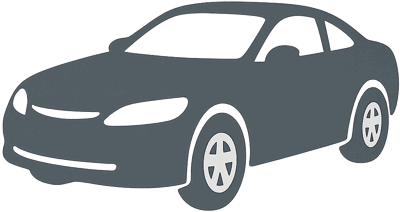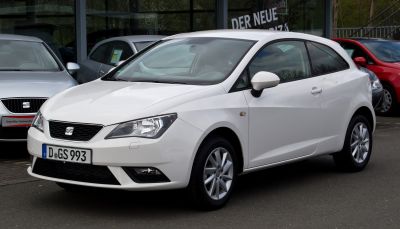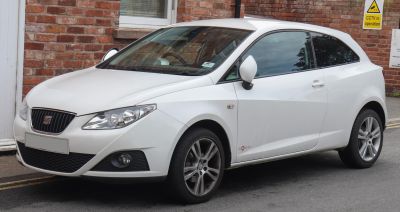 1997 Ford Puma Coupe (ECT) Dimensions, Size & Specs
1997 Ford Puma Coupe (ECT) Dimensions, Size & SpecsMeasurements of the 1997 Ford Puma Coupe, engineered for optimal performance and comfort
| Dimensions | |
|---|---|
| Length: | 3984 mm156.9 in13.1 ft |
| Width: | 1674 mm65.9 in5.5 ft |
| Height: | 1345 mm53.0 in4.4 ft |
| Trunk Capacity: | 240 liter8.5 cu ft |
| Trunk Capacity (Max): | 725 liter25.6 cu ft |
| Weight Specifications | |
| Curb Weight: | 1035-1040 kg2282-2293 lbs |
| Maximal permitted Weight: | 1400 kg3086 lbs |
| Tire Specifications | |
| Tire Size: |
|
The Ford Puma Coupe (ECT), produced from 1997 to 2003, is a compact yet sporty vehicle that blends agility with practical design. Measuring 3984 mm (approximately 157 inches) in length, 1674 mm (66 inches) in width, and standing 1345 mm (53 inches) tall, this coupe offers a snug and aerodynamic profile ideal for city driving and tight spaces. Weighing between 1035 to 1040 kilograms (2282 to 2293 pounds), the Puma maintains a lightweight structure which contributes to its nimble handling and fuel efficiency. Despite its compact size, the Puma is designed with practicality in mind, featuring a luggage capacity of 240 liters (8.5 cubic feet) to accommodate everyday cargo needs. When the rear seats are folded down, the luggage space expands impressively to 725 liters (25.6 cubic feet), allowing for greater versatility. The vehicle rides on 195/50 R15 tires that support its sporty coupé stance and stability. Overall, the Ford Puma Coupe (ECT) stands out as a distinctive compact coupe from the late 1990s to early 2000s, combining lightweight engineering with flexible cargo options suitable for drivers who value both style and practicality.
Discover the standout features that make the 1997 Ford Puma Coupe a leader in its class
Have a question? Please check our knowledgebase first.
The Ford Puma Coupe (ECT) produced between 1997 and 2003 has a length of 3984 mm (approximately 157 inches), a width of 1674 mm (about 65.9 inches), and a height of 1345 mm (around 52.95 inches). These dimensions make it a compact coupe, giving it a sporty yet practical profile for its class. The relatively low height emphasizes its coupe styling, while the width provides stable handling. These measurements are quite balanced for a small sports coupe, ensuring that it feels nimble in city driving but also spacious enough for two occupants comfortably.
The Ford Puma Coupe weighs between 1035 kg and 1040 kg (about 2282 to 2293 lbs) when empty, known as the curb weight. Its maximum allowable weight, which includes passengers and cargo, is 1400 kg (around 3086 lbs). This light curb weight contributes to its agile and responsive handling, giving it sporty performance characteristics typical of small coupes. The light weight helps in quicker acceleration and better fuel efficiency while maintaining good braking and cornering capabilities. The difference between curb and maximum weight also indicates ample capacity to carry passengers and luggage without adversely affecting drivability.
The Ford Puma Coupe offers a luggage capacity of 240 liters (approximately 8.5 cubic feet) with the rear seats in their upright position. When you fold the rear seats, this capacity significantly increases to 725 liters (around 25.6 cubic feet). This flexibility is impressive for a coupe of its size, allowing owners to transport larger items when needed. The rear seats folding make it practical for occasional use as a small cargo hauler, enhancing its appeal as a sporty car that can also manage everyday needs.
The standard tire size fitted on the 1997-2003 Ford Puma Coupe is 195/50 R15. This tire dimension provides a sporty balance between grip and comfort. The 195 mm width offers adequate road contact for good traction without compromising ride comfort excessively. The 50 aspect ratio indicates a moderately low sidewall height, which helps in precise cornering and responsive handling. The 15-inch rim size is typical for cars of this category, ensuring compatibility with a wide range of aftermarket tires if replacement or upgrades are desired.
Yes, the 1997-2003 Ford Puma Coupe fits comfortably into a standard garage. With a length of 3984 mm (157 inches), a width of 1674 mm (66 inches), and a height of 1345 mm (53 inches), the vehicle is relatively compact. Most standard residential garages have internal dimensions around 6 meters (19.7 feet) long and 3 meters (9.8 feet) wide, which provides more than enough clearance for parking the Puma. Its compact footprint makes it especially convenient for urban or suburban homes with standard garage spaces.
The 1997-2003 Ford Puma Coupe was a unique model and did not have a direct predecessor under the Puma name in the coupe segment, as Ford had mainly focused on hatchbacks and other vehicle types before this. However, compared to Ford's small sporty models of the earlier 1990s, the Puma coupe was slightly more compact and sport-focused. Its dimensions were optimized for a sleek and agile profile compared to boxier and more practical Ford small cars previously available. This generation marked Ford’s entry into creating a nimble and stylish coupe distinct from its utilitarian predecessors.
Compared to other sporty compact coupes from the late 1990s and early 2000s, the Ford Puma is notably lightweight and compact. With a curb weight around 1035-1040 kg (2282-2293 lbs), it is lighter than many contemporaries such as the Toyota Celica or Honda CR-X Del Sol. Its length of just under 4 meters (3.984 m) is shorter than many similar coupes, enhancing its nimbleness and city driving ease. While its interior and cargo space are competitive, the Puma's combination of size and weight made it appealing for drivers who valued sharp handling and lively driving dynamics in a small package.
Being a compact coupe, the Ford Puma (ECT) features limited rear seat space suitable mainly for short trips or smaller passengers. The front seats are designed to offer good support and comfort, ideal for sporty driving. The overall interior is compact but well laid out, favoring driver engagement over extensive passenger room. Given its coupe chassis and dimensions—length of 3984 mm and width of 1674 mm—the car prioritizes a snug and sporty cabin experience rather than spaciousness. However, the clever design of folding rear seats adds practicality, enhancing luggage flexibility.
The relatively low curb weight of the Ford Puma Coupe (around 1035 to 1040 kg or 2282 to 2293 lbs) positively influences fuel efficiency and daily usability. Lighter vehicles generally require less energy to move, thus improving fuel economy compared to heavier cars within the same class. The Puma's light construction means it can deliver brisk acceleration and nimble handling without sacrificing efficiency. This makes it an appealing choice for daily driving, especially in urban environments where agility and lower fuel consumption are desirable. Additionally, this weight balance improves the overall driving experience by making the car responsive and easy to maneuver.
The 1997-2003 Ford Puma Coupe is distinguished by its sporty design, lightweight construction, and excellent handling characteristics for its segment. It was designed with a focus on driver engagement, featuring a compact and aerodynamic body with a sleek coupe roofline. Paired with its modest curb weight (1035-1040 kg), it offered agile and responsive driving dynamics uncommon in many other small coupes of the period. Additionally, the Puma was praised for its well-tuned suspension and precise steering, making it a favorite among enthusiasts looking for a fun-to-drive yet practical vehicle. Its unique combination of practicality with sportiness helped it build a loyal following.
Discover similar sized cars.

| Production: | 2015-2017 |
|---|---|
| Model Year: | 2015 |
| Length: | 4043-4055 mm159.2-159.6 in |
| Width: | 1693 mm66.7 in |
| Height: | 1420-1428 mm55.9-56.2 in |

| Production: | 2012-2015 |
|---|---|
| Model Year: | 2012 |
| Length: | 4043-4066 mm159.2-160.1 in |
| Width: | 1693 mm66.7 in |
| Height: | 1420-1428 mm55.9-56.2 in |

| Production: | 2008-2012 |
|---|---|
| Model Year: | 2008 |
| Length: | 4034-4072 mm158.8-160.3 in |
| Width: | 1693 mm66.7 in |
| Height: | 1420-1428 mm55.9-56.2 in |
